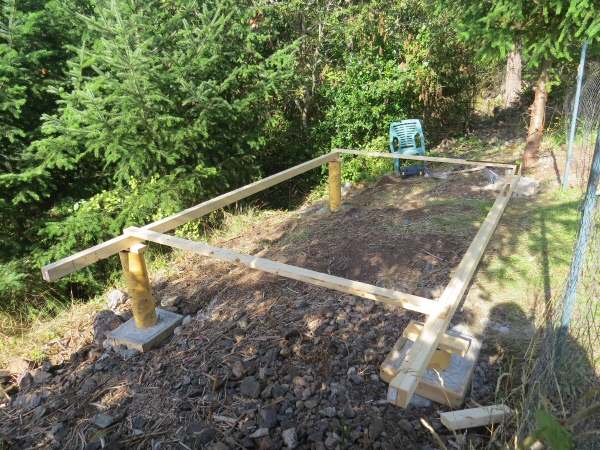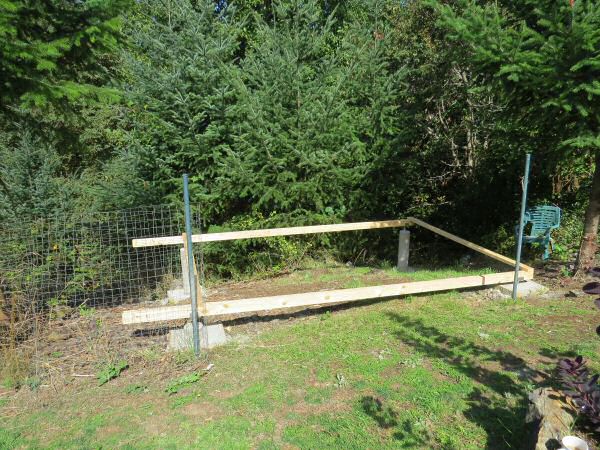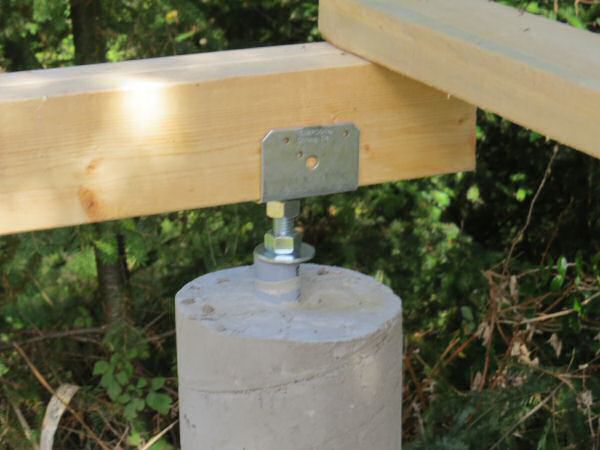GrowerNode™ is the name for our greenhouse and garden environmental sensing and control system. It is an internet based system for sensing and control of greenhouse, field and garden operations. The 'Islander' is our small prototype greenhouse design used as a demonstration project.
In Part 3, we showed how we did the site prep and layout of the forms for the foundation pier footings, Part 4 will cover the details of the concrete pour for the pier columns.

In the above picture, the setup is done for the corner footing pier columns pour. We spent quite a lot of time on this, making it as precise as possible, and the rectangular beam assembly holds the Quickrete™ tube forms nicely in place. We will lift it off to do the pour, then put it right back on again to lock the vertical alignment of the columns.

Note how we are embedding large galvanized bolts into the concrete, about 15" and 20" down from top of concrete column. There is actually more of the bolt inside the tube than the length that is protruding. These will be used later to anchor the 2x6 bracing gussets that will support the cantilevered deck extension we are adding to this version of the Islander greenhouse. It will also provide more resistance to lateral stresses for the overall structure.
Tomorrow we will do the actual pour, then we'll be ready to start framing the main structure. Here's a recap of the volume calculations:
V = Πr2 x H (read like this: Pi x radius squared x height)
V = 3.14 x 3" x 3" x 24"
V = ~678 cubic inches
The size of Quickrete bags we used are specified as 19" x 12" x 4", so the volume is:
V = Length x Width X Height
V = 19" x 12" x 4"
V = ~912 cubic inches

You can clearly see the bolts embedded in the concrete for the bracing gussets that will provide additional lateral support for the structure and the cantilevered deck overhang.


The next step will be to construct the insulated floor modules. Later we will insert the tubing that will form a circulating thermosiphon for winter heating. The intent of the design of this greenhouse is to create a modular, scalable unit that can grow produce year-round in a cold climate.
The computerized 'smart' system will include a detailed data logging system that will track temperature sensors in various places in the structure. This information will be uploaded to our high speed database servers that will display a detailed history of daily temperature fluctuations on a public web page.
GrowerNode™ Greenhouse Construction Index (The Islander):
Part 1: Greenhouse Construction: Introduction
Part 2: Greenhouse Construction: Site Prep & Footings Forms
Part 3: Greenhouse Construction: Foundation Concrete Footing Pour
Part 4: Greenhouse Construction: Foundation Pier Column Setup (you are here)
Part 5: Greenhouse Construction: Bubble Wrap Insulation re Floor Joist Modules
Part 6: Greenhouse Construction: Framing the Structure for Bubble Wrap vs Glass Walls
Part 7: Greenhouse Construction: Roof Module Installation
Part 8: Phase 1 Completed, Ready for Finishing Stain & Bubble Wrap Skin